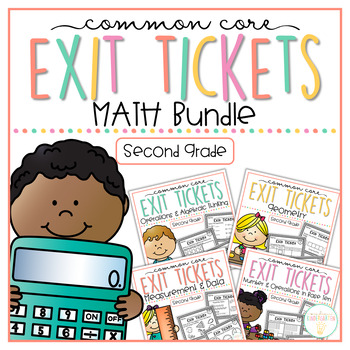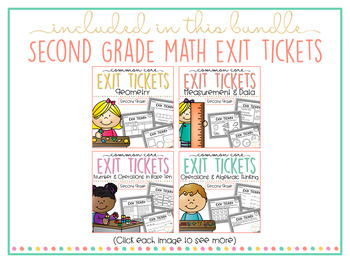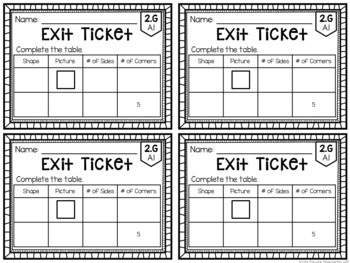Common Core Exit Tickets: Second Grade Math Bundle
- Zip
What educators are saying
Products in this Bundle (4)
Description
Review and Assess with Exit Tickets!
Are you looking for a quick snapshot of your students’ understanding of math concepts?
Try this Common Core Exit Ticket Bundle for Second Grade Math Standards! This pack includes quick and easy exit tickets for all 26 second grade math standards. Each exit ticket contains 1-8 questions to check student understanding of the common core standard. Each concept has 4 different options to differentiate for different levels of students and reassess as needed. EDITABLE data tracking spreadsheets are included to keep you organized and save time.
Features:
• 213 different exit tickets (with 4 of the same on each page for easy copying)
• Black and white only to save on ink
• Common Core Standard listed on each ticket for quick reference/organization
• Addresses all 26 Second Grade Math Standards
Geometry:
-Recognize & Describe 2D Shapes (2.G.A.1)
-Recognize & Describe 3D Shapes (2.G.A.1)
-Draw & Partition Rectangles (2.G.A.2)
-Partition Rectangles (2.G.A.2)
-Halves, Thirds, and Fourths (2.G.A.3)
-Shade Fractions (2.G.A.3)
-Label Fractions (2.G.A.3)
Operations and Algebraic Thinking:
-Word problems (Result unknown) (2.OA.A.1)
-Word problems (Change unknown) (2.OA.A.1)
-Word problems (Start unknown) (2.OA.A.1)
-Word problems (2 Step: Same Operation) (2.OA.A.1)
-Word problems (2 Step: Differ. Operations) (2.OA.A.1)
-Fact fluency (+/- 1 or 2) (2.OA.B.2)
-Fact fluency (Make 10) (2.OA.B.2)
-Fact fluency (Doubles) (2.OA.B.2)
-Fact fluency (Near Doubles) (2.OA.B.2)
-Fact fluency (+/- 10) (2.OA.B.2)
-Odd and even (2.OA.C.3)
-Interpret arrays (2.OA.C.4)
-Create arrays (2.OA.C.4)
Measurement and Data:
-Measurement Tools & Units (2.MD.A.1)
-Measure Objects (2.MD.A.1)
-Measurement Conversions (2.MD.A.1)
-Measuring with Different Units (2.MD.A.2)
-Concept of Length (2.MD.A.3)
-Estimate & Measure (2.MD.A.3)
-Difference in Lengths (2.MD.A.4)
-Add & Subtract with Measurements (2.MD.B.5)
-Missing Number Lines (2.MD.B.6)
-Open Number Lines (2.MD.B.6)
-Solve with a Number Line (2.MD.B.6)
-Tell Time from Analog Clock (2.MD.C.7)
-Tell Time from Digital Clock (2.MD.C.7)
-Count Sets of Coins (2.MD.C.8)
-Count Sets of Bills and Coins (2.MD.C.8)
-Represent Amounts in Different Ways (2.MD.C.8)
-Word Problems with Money (2.MD.C.8)
-Create a Line Plot (2.MD.D.9)
-Interpret a Graph (2.MD.D.10)
-Create a Graph (2.MD.D.10)
Numbers and Operations in Base Ten:
-Count base ten blocks (2.NBT.A.1)
-Draw base ten blocks (2.NBT.A.1)
-Values in 3 digit numbers (2.NBT.A.1)
-Count On/Back (2.NBT.A.2)
-Skip Counting Patterns (2.NBT.A.2)
-Number Words (2.NBT.A.3)
-Expanded Form (2.NBT.A.3)
-Compare Numbers (2.NBT.A.4)
-Add within 100 (2.NBT.B.5)
-Add 4 numbers (2.NBT.B.6)
-Add/Subtract within 1000 (Using an open number line)(2.NBT.B.7)
-Add/Subtract within 1000 (Using base ten blocks)(2.NBT.B.7)
-Add and subtract 10 or 100 (2.NBT.B.8)
-Solve and explain (2.NBT.B.9)
• Answer Keys included for easy grading
• EDITABLE Data tracking spreadsheets
*****************************************************************************
Check out more Baby Bin Resources for 1-2 year olds here.
Check out more Tot School Resources for 2-3 year olds here.
Check out more Preschool Resources for 3-4 year olds here.
*****************************************************************************
Customer Tips:
Quick and Easy way to get TPT credit to use on future purchases:
• Go to your My Purchases page. Beside each purchase you'll see a Provide Feedback button. Click it and you will be taken to a page where you can give a quick rating and leave a short comment for the product. Each time you give feedback, TPT gives you feedback credits that you use to lower the cost of your future purchases. I read all feedback, and value your thoughts and suggestions!
Be the first to know about my sales, freebies and new products:
• Look for the green star next to my store logo and click it to become a follower. Easy Peasy! You will now receive updates about this store.





